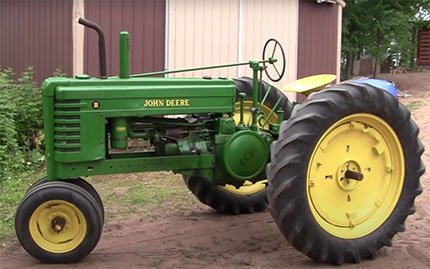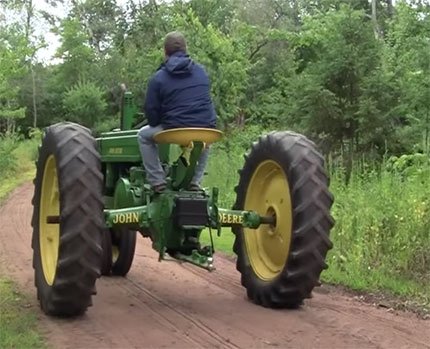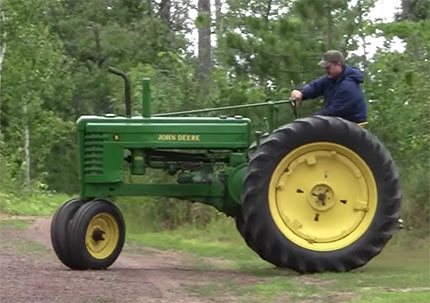John Deere B reviews are the best solution when you need a smaller row crop tractor. The article helps you learn:
- Product line history
- Tractor specs
- Overall benefits
- Alternative options
So, if you need to know more about the John Deere B tractor, read the guidelines below to answer all your questions.
Take Away Key Points
- The John Deere B tractor was the second generation of row-crop units after the famous A tractors. It was later replaced by the 50, 520, and 530 units.
- The B Series came in various categories and were smaller and more compact for various farm operations.
- The tractor provided 17 HP with a 2-cylinder or an all-fuel engine for the farmers’ convenience.
Table of Contents
- John Deere B Tractor Reviews: Learn Its Value!
- 1. John Deere B history
- 2. John Deere B dimensions
- 3. John Deere B mechanicals
- 4. John Deere B transmission
- 5. John Deere B engine
- 6. John Deere B power
- 7. John Deere B PTO
- 8. John Deere B belt pulley
- 9. John Deere B tires
- 10. John Deere electrical mechanism
- 11. John Deere B attachments
- 12. What are the alternatives?
- Final Words
John Deere B Tractor Reviews: Learn Its Value!
If you’re still wondering whether or not you should select the John Deere B row-crop tractor as your primary solution, the data below will help you decide.
1. John Deere B history

The John Deere B Model was a famous two-plow row-crop tractor produced between 1935 and 1952.
The B model replaced the John Deere A tractor. It was much smaller (around two-thirds of the A’s model) and less expensive than the A product.
The B tractor was sold for the original price of $1,900. And the total number of tractors produced between 1935-1952 was 40,057.
The B tractor was intended for row-crop farmers who needed smaller units. It came in several categories, including:
- B: midsize row-crop
- BR: regular use
- BO: orchard use
- BI: industrial use
- BN: narrow row-crop
- BW: wide row-crop
- BO Lindeman: the final version, specific for crawlers instead of wheels/tires.
In addition, the tractor included different serial numbers, such as:
- 1935: 1000
- 1936: 12012
- 1937: 27389
- 1938: 46175
- 1939: 60000
- 1940: 81000
- 1941: 96000
- 1942: 118721
- 1943: 136315
- 1944: 149219
- 1945: 167700
- 1946: 179788
- 1947: 191303
- 1948: 209295
- 1949: 230044
- 1950: 253025
- 1951: 275242
- 1952: 293030
- Final: 310772
2. John Deere B dimensions
Unlike other row-crop machines, the John Deere Model B is smaller and more compact for various operations. Thus, it’s ideal for smaller farms and fields, but it’s as effective as the larger tractors due to its power and performance.
Let’s check the dimensions first.
Dimensions specs
| Length | 120.5 inches (306 cm) |
| Width | 85 inches (215 cm) |
| Height (hood) | 56 inches (142 cm) |
| Weight | 3,275 lbs (1485 kg) |
| Rear tread | 56-84 inches (142-213 cm) |
3. John Deere B mechanicals
In addition to the dimensions, we must analyze the wholesome construction, too. As a smaller machine, the tractor didn’t have a closed cabin like other models.
Instead, it used the open operator station. Thus, it resembled the A model.
Refer to additional mechanical data below.
Mechanics specs
| Chassis | 4×2 2WD |
| Steering | Manual |
| Brakes | Differential mechanical expanding shoe |
| Cab | Open operator station with the pressed steel seat |
| Transmission | Four-speed unsynchronized gear |
4. John Deere B transmission
Being an old model, the tractor doesn’t provide variations of transmission, as it’s the case with the latter, newer models (4440, 4430, 3020, and similar models).
Instead, the production of the B series tractors was focused on the manual, unsynchronized gear transmission.
As a result, the transmission required a driver to adapt the incoming/outcoming speed of the gearbox manually. Besides, the clutch mechanism used the dry disc instead of the wet disc.
Transmission specs
| Manufacturer | John Deere |
| Type | Unsynchronized gear |
| Gears | Four forward gears and one reverse gear |
| Clutch | Dry disc |
5. John Deere B engine
The John Deere B model was famous for its 3.1l 2-cylinder gasoline engine. However, the tractor was also equipped with the John Deere 3.1l 2-cylinder all-fuel engine.
Farmers find the optional-only gasoline featuring higher compression than the all-fuel engine.
In addition, the engine produced approximately 28 horsepower, so it was ideal for smaller row-crop tasks and different ground operations for its time.
Gasoline engine specs
| Displacement | 149 ci (2.4L) |
| Bore/Stroke | 4.25×5.25 inches (108 x 133 mm) |
| Fuel system | Marvel-Schebler DLTX-10 |
| Cooling system | thermo-siphon |
| Air cleaner | Oil bath |
| Compression | 4.71:1 |
| Rated RPM | 975 |
| Firing order | 1-2 |
| Starter type | hand-crank |
| Oil capacity | 7 qts (6.6 L) |
| Coolant capacity | 22 qts (20.8 L) |
| Spark Plug gap | 0.030 inches (0.762 mm) |
| Point gap | 0.015 inches (0.381 mm) |
| Intake valve clearance | 0.020 inches (0.508 mm hot) |
| Exhaust valve clearance | 0.020 inches (0.508 mm hot) |
6. John Deere B power

Although a small tractor, the model ran effectively and was able to handle various light and complex farm tasks.
The converted power was ideal for difficult operations on smaller fields, and the tractor could keep running for long hours and work more robustly.
Let’s see the details.
Power specs
| Gross power | 17 horsepower (13 kW) |
| Drawbar (claimed) | 12 HP (8.9 kW) |
| Belt (claimed) | 16 HP (11.9 kW) |
| Plows | 2 (10-inch) |
| Drawbar (tested) | 11.8 HP (8.8 kW) |
| Belt (tested) | 16.01 HP (11.9 kW) |
7. John Deere B PTO
As with other John Deere models, the John Deere B tractor was also equipped with the PTO shaft. Thus, it could transform the engine energy into tractor implements and similar parts.
So, farmers could perform multiple operations and finish the project quickly.
PTO specs
| Rear PTO | Transmission |
| Rear RPM | 540 |
| Hitch | Power lift type |
8. John Deere B belt pulley
Unlike the more modern machinery, the B’s tractor model was specific for its belt pulley piece of equipment.
The belt drove off the PTO shaft and allowed tractor attachments and implements to be driven by the belt mechanism.
Remember that these variations were the only support back in the day, as they are ancient nowadays.
Belt pulley specs
| Diameter | 9.6875 inches (24 cm) |
| Width | 7.25 inches (18 cm) |
| RPM | 1250 |
| Speed | 3110 ft/min (947.93 meters/min) |
9. John Deere B tires
The John Deere B unit offered good front and rear tires with a steel combination to be productive and efficient.
The tires moved smoothly on the ground, and the quality of the materials ensured durability and sturdiness. So, farmers thought the model was a real expert on the farm.
Check the table below for more data
Tires specs
| Ag front | 22×3.25 (steel) |
| Ag rear | 48×5.25 (steel) |
10. John Deere electrical mechanism
The B models come in various serial numbers. Check the instruction manuals and find the serial number to match the voltage needed for smooth engine power.
For instance, some models include 5V or 7.5V batteries (’51 tractor), while others might need a 6V, 12V, or two 6V batteries to make it 12V (’47 tractors.)
However, the serial number in the manual corresponds even if you want to change some things and turn the inner construction into something more modern.
But be careful when changing the parts, as you might damage the internal structure. Still, the electrical ground of the tractor is always positive.
Electrical system specs
| Ground | Positive |
| Battery voltage | 6V |
11. John Deere B attachments

The review shows that the John Deere B suits various attachments, but the head attachment is the John Deere 40 loader.
First, let’s see its specs.
John Deere 40 loader specs
| Height (to pin) | 114 inches (289 cm) |
| Breakout force (bucket) | 1800 lbs (816 kg) |
| Lift to full height (at pin) | 800 lbs (362 kg) |
| Bucket width | 36 inches (91 cm) |
12. What are the alternatives?
Although farmers could choose among various categories of the John Deere B Series (orchards, industry, row-crop, and other units), the review shows that they could also use other products that replaced the production of the B series.
The newer production included:
- John Deere 50
- John Deere 520
- John Deere 530
a. The John Deere 50
The John Deere 50 had a new cast frame and improved style, unlike the B. The power was also increased by 10% of the same engine.
However, the Deere 50 included advanced PTO, live hydraulics, and rack-and-pinion rear wheel adjustment. The fuel options had all-fuel, gasoline, and LP-gas engines.
The cost was also increased, and the 50 models were sold for the original price of $2,011.
b. The John Deere 520
The John Deere 520 was introduced in 1957 and was far more advanced. It surpassed even the JD 50 tractor. It had 20% more power output and a new two-cylinder engine. The 520 tractor could work three plows.
The tractor was equipped with the same fuel options, but only row-crop versions were available. Farmers had to pay $2,300 for the original price.
c. The John Deere 530
Finally, the John Deere 530 model was introduced in 1958, and the review shows only row-crop models.
The product was famous for adding fenders, four headlights, and power adjustments for rear wheel track width were also available.
Farmers could purchase it for the original price of $2,400.
However, all the units listed here had the open operator station cabin. This was the main similarity.
Final Words
We hope we helped you better understand the John Deere B Series’s value. Unfortunately, the models are too old for modern times, but some still use the tractor for small farms.
And if you like them as old-timers, you can check the price with your local distributor or look for them at local auctions.
